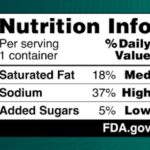The FDA is proposing updates to front of package nutrition labels to help consumers make healthier choices. The rule would require a front-of-package (FOP) nutrition label on most packaged foods. These labels would give consumers more information at a glance. This label is called the "nutrition info box," and it would complement the longer label already on these products that is usually found on the back or side panel. The difference is that the new label would amplify the most important nutrient information about saturated fat, sodium, and added sugars. The contents would be labeled "Low," Med," or "High," to give consumers information at a glance. These descriptive terms follow federal dietary recommendations and may encourage consumers to choose more nutrient-dense … [Read more...]
FDA Issues Final Guidance For Lead in Children’s Food
The FDA has issued final guidance for lead in children's food. These action levels reflect the levels of lead at which the FDA may regard the food as adulterated. While there are no safe levels of lead consumption, it is not possible to completely remove lead from every food as the heavy metal occurs naturally and is found in air, water, and soil. This guidance supports the Closer to Zero initiative to reduce exposure to contaminants through food to as low as possible. The action levels are 10 parts per billion for fruits, vegetables (except single ingredient root vegetables), mixtures (including grain and meat based mixtures), yogurt, custards and puddings, and single ingredient meats. The level is 20 parts per billion for single ingredient root vegetables, and 20 parts per billion … [Read more...]
Cooking More at Home? Use the Nutrition Facts Label
With more people cooking at home since restaurants are closed for the coronavirus pandemic, the FDA is offering information about the nutrition facts label to help you learn more about the foods you buy. Many people haven't look at a nutrition label in a while, so it's good to be informed. There are several labels on foods. Those labels are important for several reasons. First of all, it's where the potential allergens that ma be in the food are listed. You'll also find the calorie count per serving: this is important, since many people don't realize how many servings is actually in each container of food. In the new nutrition facts label, the calorie count is displayed in larger, bolder font. Some serving sizes are updated to better reflect what people actually eat and drink. … [Read more...]
UNICEF Study Finds Most Children Under Two Undernourished
A study conducted by UNICEF has found that five in six children under the age of two worldwide are not fed enough nutritious food for their age. This deprives them of the nutrients they need at a critical time for brain development. During the first two years of life, nutrition is critical to body and brain development. There has been a reduction in chronic malnutrition in the past decade, but the number of children at the opposite ends of the nutrition spectrum are alarming. More than 150,000,000 children under the age of 5 are stunted because of malnutrition, and 42,000,000 children are overweight or obese, an increase of 11,000,000 since 2000. The study says that breastfeeding gives children the best start, and they should be fed this way until the age of 2. In addition, … [Read more...]
Making Sure ‘Healthy’ Means What It Says on Food Labels
Most consumers have learned to read food packages to learn about calorie counts, sodium amounts, and vitamin and mineral content in the foods they buy in the grocery store. But what about claims made on food packages? Does the term 'healthy' really mean what it says? The FDA has published final rules on the Nutrition Facts label on food products. An updated label will make the calorie counts in the product and the serving sizes easier to see and will also provide more information on added sugars and the content of vitamin D and potassium in the food. But even if you know something about nutrition and know what to look for on a food label, it can be difficult to know if the foods you buy add up to a healthy diet. Terms such as "good source," "healthy," or "low in fat" should only … [Read more...]
How Much Salt Do You Really Eat?
The FDA is warning consumers that they may be consuming far more salt than they think. Even if you don't salt your food at the table or while cooking, you are probably consuming a lot of sodium, especially if you eat prepared or processed foods. Most of the sodium in the American diet comes from supermarket foods and restaurant meals. So the FDA is working to gradually reduce the amount of sodium that processors add to food. Draft guidance for industry has been released that sets voluntary goals for reducing sodium levels in processed and prepared foods. Note that their guidance is voluntary, which means that processors and restaurants do not have to abide by the levels. The maximum sodium intake per day for adults should be about 2,300 milligrams, which is the amount in a … [Read more...]
FDA Wants to Reduce Sodium in the Food Supply
The FDA is planning to reduce sodium in the food supply. The link between sodium consumption and blood pressure is well documented. Most people need to reduce their sodium consumption to less than 2,300 mg per day. And most of that consumption, about 75%, comes from processed and prepared foods, not the salt shaker. Some companies have reduced sodium in their products, but many foods still contain a lot of salt. On average, Americans consume 3,400 mg of sodium every day, more than 50% above the recommended limit. Children also eat more than is recommended. Most children consume from 2,900 mg a day, and teenagers consume 3,700 mg per day. High blood pressure is a major risk factor for heart disease and stroke. A lower sodium intake is associated with a lower risk of cardiovascular … [Read more...]
Study Finds WIC Improves Preschool Children’s Diet
A study conducted by the UCSF Benioff Children's Hospital in Oakland, California has found that WIC (USDA Special Supplemental Nutrition Program for Women Infants and Children) improves preschool children's diets. A change made in that program in 2009 provided more fruits, vegetables, whole grains, and low fat milk in the food voucher package. Diet quality improved for the 4 million children who are served by this federal program. Unfortunately, some in Congress want to cut this efficient and effective program. In the past few years, Republicans in Congress have tried to cut WIC funding, despite the fact that the program improves birth weight, decreases infant mortality, and improves food security. In fact, the program has faced an 8% cut in the past five years, and many WIC clinics … [Read more...]
New 2015-2020 U.S. Dietary Guidelines Released
The Obama administration has released new dietary guidelines for 2015 - 2020, as is standard every five years. They state that nutrition and health are closely related. A message from the Secretaries of Health and Human Services and USDA states that about half of American adults have preventable chronic diseases related to poor dietary habits. The focus of this edition is on disease prevention, not treatment. The main purpose of the Guidelines is to inform the development of Federal food, nutrition, and health policies and programs, such as the National School Lunch Program, Women Infants and Children (WIC) and the Administration on Aging. Since the rates of chronic illnesses have increased, the government wants Americans to focus more on healthy nutrition and more exercise. The most … [Read more...]
Report Finds Trans Fats Increase Mortality Risk
A study published in the BMJ (British Medical Journal) has found that consumption of trans fats is associated with greater risk of mortality, a greater risk of dying from heart disease, and a greater risk of developing heart disease. Researchers in Canada reviewed 41 observational studies, which means the association cannot be "causal". But the certainty between trans fat consumption and coronary heart disease is "moderate", and the certainty between saturated fat and all mortality outcomes is "very low". Dietary guidelines recommend that saturated fats should be limited to less than 10% of daily calorie intake. The report concludes that "Saturated fats are not associated with all cause mortality, CVD, CHD (coronary heart disease), ischemic stroke, or type 2 diabetes, but the … [Read more...]












